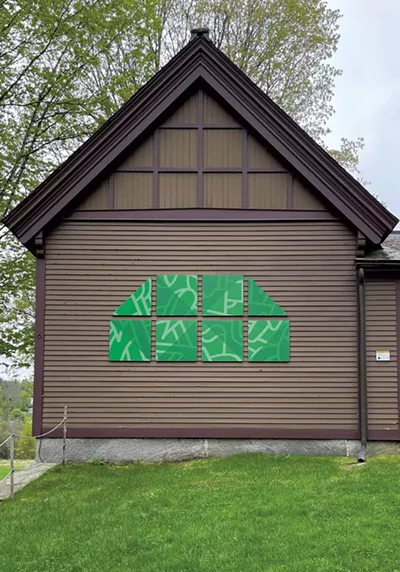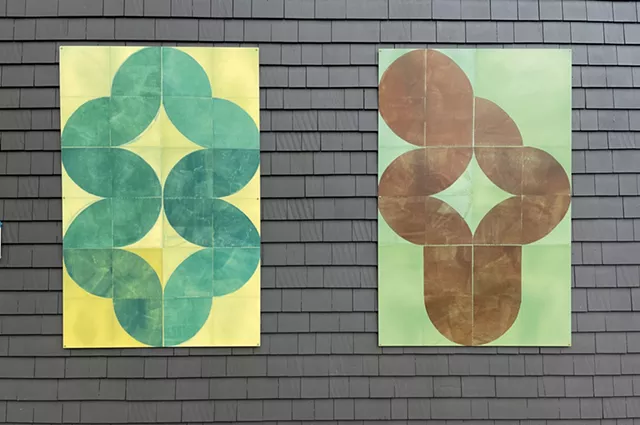Barns feature prominently in Vermont’s collective artistic oeuvre: red ones, yellow ones, barns at sunrise, barns at night, falling-down barns. The subject is a cliché or a classic, depending on whom you ask. But Billings Farm & Museum in Woodstock is doing something a little different: Instead of art of barns, it has art on barns.
Curator Sherlock Terry teamed up with Patricia Trafton, director of Soapbox Arts in Burlington, to invite artists Elise Whittemore and Will Gebhard to develop work for the second annual incarnation of “Art on the Barns,” on view into February.
Gebhard, a painter who studied graphic design at Champlain College and now lives in Vietnam, worked remotely with the Billings Farm team to create his geometric drawings, sending the curatorial staff sample colors to photograph against the architecture. Whittemore, a printmaker in Grand Isle, developed a series of sewn monoprints specific to each setting, directing installation on-site. All the works have been printed at a large scale and mounted on the exteriors of barns and other museum buildings.
Terry said Gebhard was inspired by barn quilts — which are not fabric but large, abstract paintings resembling single quilt blocks and that are hung on the outside of barns. “Will’s kind of taken that idea of place-marking,” Terry said, where instead of relying on a name or signage, each building is identified with a design in a different bold color.
Whittemore regularly uses the concept of quilts in her work, creating repeated arcs and patterns in blocks, flipping and mirroring shapes. She also uses machine stitching, sewing together paper prints. Those stitches are visible in works such as “There and Back” and “Awkward Character,” both mounted close to ground level at the back of the museum’s main building, where viewers can get up close to see the details clearly.
Billings Farm was established in 1871 as a model farm, and it’s still a working operation. Visitors can explore the 1890 farm manager’s house with its then-state-of-the-art creamery equipment and fancy parlor, pat velvety-soft Jersey cows, and marvel at powerful draft horses. The museum hosts temporary exhibitions, including this summer’s juried show, “A Vermont Quilt Sampler,” which opens on June 28.
Though the outdoor show is conceptually tied to that presentation, both are less traditional than visitors might expect — the quilt show is limited to works created across the state in the past two years. With “Art on the Barns,” Terry said, “The idea is really to highlight some contemporary artists.”
The most remarkable thing about Whittemore and Gebhard’s works is that they, in turn, highlight the farm’s architecture and landscape. Gebhard’s “Windows,” made up of eight panels in shades of green mounted to the farm manager’s house, mirrors woodwork panels and the roofline of a gable above it. It also reflects the shape and color of a grassy slope leading up to the house, tying both together.
Whittemore’s three-panel “Paper Chain I, II & III,” mounted on a wall between two joined silos, seems to continue the lines of wooden boards and metal reinforcements that contribute to the building’s visual geometry, enlivening dark brown paint with pumpkin orange and wine red. Her “Double Twist I, II & III,” outside the draft horse barn, is, at the moment, the exact bright green of the spring grass in the yard below.
The works look different with the seasons and weather, Terry said, giving visitors a new experience every time. This way of looking at art — outside the white-cube gallery and affected by a real farm landscape — offers viewers a refreshing, contemporary take on the subject of barns.
Just remember to watch where you step.


